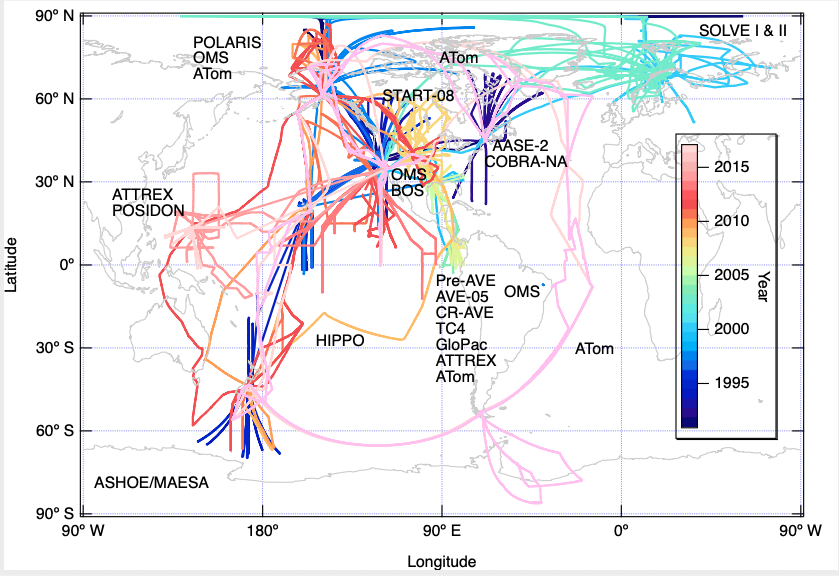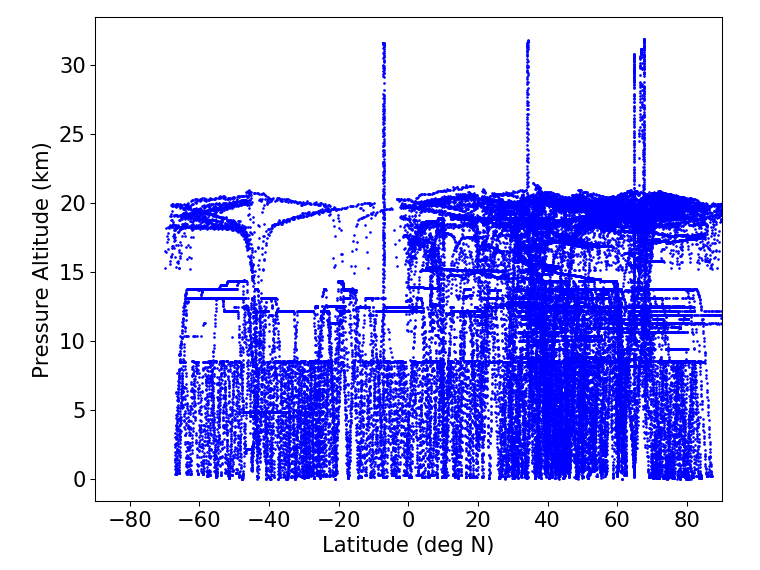HATS Airborne Data
The NOAA/GML/HATS group has assembled in one place trace gas measurements from its entire three decade history of involvement in cooperative airborne measurement campaigns. These data have always, for the most part, been available from several archive sites accessible to the public where they are kept in a despersed form under multiple campaign umbrellas and their associated research flights. Links to these archive sites are available at the campaign acronyms listed below. Links to overview descriptions of the science objectives targeted during each campaign are available from the HATS Airborne Projects page.
Link to HATS airborne data file
Typically, cooperating researchers are responsible for the data from one or more instrument systems that they build and maintain themselves, and the data that each system produces arrives at the campaign archive in standalone form divided among individual research flights. Each instrument team also customarily offers only a sychronized time vector for matching with the data streams from other instruments. As such, measurement placement and sychronization on a flight by flight basis is a cumbersome process.
Fortunately, we have done much of this work already and packaged HATS system trace gas measurements from all reported flights of all of the airborne campaigns we have had the privilege to be involved in since 1991 into a single HATS airborne data file. The measurements available in the this file are currently limited to those from the ACATS-II, ACATS-IV, LACE, PANTHER, UCATS, and NWAS-PFP systems, with navigational and atmospheric state parameters supplied by platform operators. The data are stored in a simple text format with comma-separated values. Because no HATS system measures all of the parameters reported in this file at the same time, much of the actual storage space required for the file is reserved for missing values. Future releases will seek to curtail this problem and speed up access with the implementation of a better organized and more robust storage format that will also include measurement uncertainty estimates where appropriate and available. These have been left out for now owing to the practical limitations of the csv format.
The following is a list of the parameters supplied in order of ascending column number:
- Mission/Platform (no units, char, campaign name and platform type)
- MissionIndex (sequence number, integer)
- DeploymentIndex (sequence number, integer, for multi-part missions)
- FlightDate (UTC, yyyymmdd, date of takeoff)
- FlightType (no units)
- daysec (UTC, int, seconds since midnight of takeoff date)
- Date (UTC, yyyy-mm-dd, date of measurement)
- Time (UTC, HH:MM:SS, time of measurement)
- Year (UTC, float, time of measurement)
- lon (deg E, float, longitude)
- lat (deg N, float, latitude)
- palt (km, float, pressure altitude)
- galt (km, float, gps altitude)
- P (hPa, float, environmental pressure)
- T (K, float, environmental temperature)
- O3 (ppb, float, ozone)
- CO2 (ppm, float, carbon dioxide)
- CH4 (ppb, float, methane)
- CO (ppb, float, carbon monoxide)
- OCS (ppt, float, carbonyl sulfide)
- H2 (ppb, float, molecular hydrogen)
- N2O (ppb, float, nitrous oxide)
- SF6 (ppt, float, sulfur hexaflouride)
- CFC-11 (ppt, float, trichlorofluoromethane)
- CFC-12 (ppt, float, dichlorodifluoromethane)
- CFC-13 (ppt, float, chlorotrifluoromethane)
- CFC-113 (ppt, float, 1,1,2-trichloro-1,2,2-trifluoroethane)
- CFC-114 (ppt, float, 1,2-dichlorotetrafluoroethane)
- CFC-115 (ppt, float, chloropentafluoroethane)
- HCFC-21 (ppt, float, dichlorofluoromethane)
- HCFC-22 (ppt, float, chlorodifluoromethane)
- HCFC-141b (ppt, float, 1,1-dichloro-1-fluoroethane)
- HCFC-142b (ppt, float, 1-chloro-1,1-dichloroethane)
- HCFC-123 (ppt, float, 2,2-dichloro-1,1,1-trifluorethane)
- HCFC-124 (ppt, float, 1-chloro-1,2,2,2-tetrafluorethane)
- HFC-125 (ppt, float, pentafluoroethane)
- HFC-23 (ppt, float, fluoroform)
- HFC-134a (ppt, float, 1,1,1,2 tetrafluoroethane)
- HFC-143a (ppt, float, 1,1,1 trifluoroethane)
- HFC-152a (ppt, float, 1,1 difluoroethane)
- Halon-1211 (ppt, float, bromochlorodifluoromethane)
- Halon-1301 (ppt, float, bromotrifluoromethane)
- Halon-2402 (ppt, float, dibromotetrafluoroethane)
- CCl4 (ppt, float, carbon tetrachloride)
- CH3CCl3 (ppt, float, methyl chloroform)
- CH3Cl (ppt, float, methyl chloride)
- CH3Br (ppt, float, methyl bromide)
- CH3I (ppt, float, methyl iodide)
- CHCl3 (ppt, float, chloroform)
- CHBr3 (ppt, float, bromoform)
- Source (no units, char, instrument name for gas measurement)
Three decades of HATS research flight tracks

Three decades of HATS airborne sampling locations in latitude-altitude space

For Further Information Contact: Dr. Fred Moore or Dr. James Elkins
